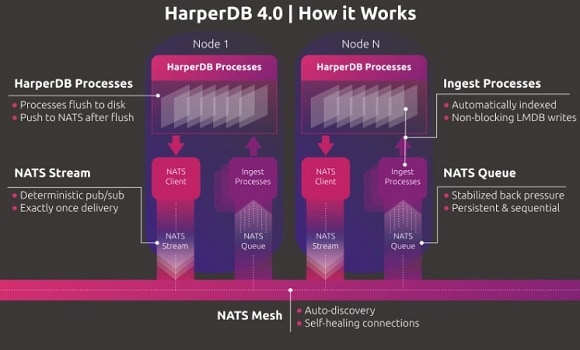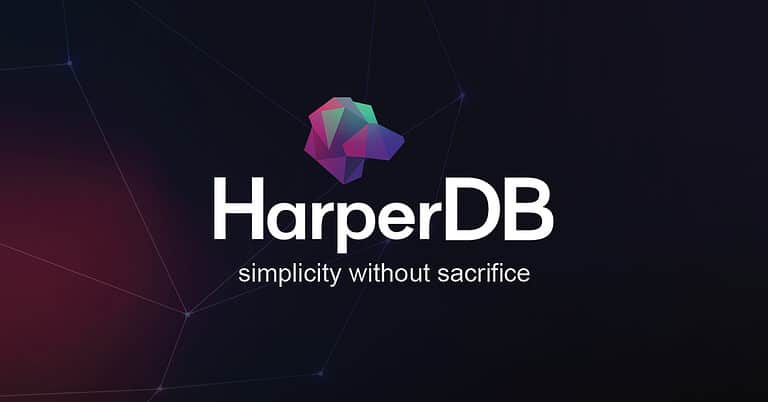HarperDB is a distributed database product for the collection, distribution and analysis of data throughout an organisation.
This year, we see the database hit its version four (dot oh) iteration.
This company makes much of its key features, which include the fact that developers can write business logic in any language and run it with HarperDB… they can also create APIs, train and deploy ML/AI and process data anywhere.
With HarperDB 4.0, connectivity extends even further thanks to its NATS open source connective technology for adaptive edge and distributed systems.
What is NATS?
NATS is a connective technology that enables applications to securely communicate across any combination of cloud vendors, on-premises, edge, web and mobile and devices. NATS consists of a family of open source products that are tightly integrated but can be deployed independently.
In addition to furthering HarperDB’s objective of simplifying global application development, integrating NATS also improves the underlying economics of scale.
“Our mission is to rethink connectivity while simplifying the lives of developers, giving them a modern platform for all of their connectivity requirements – with no compromises on performance, location, or scale,” said Synadia CEO & founder Derek Collison. “HarperDB’s vision of providing a resilient and globally available application platform, not tied to a specific cloud infrastructure, is a great fit for the core tenets of why we created NATS and we are very excited about what the partnership will bring to customers.”
Synadia maintains and leads the development of NATS.io, which is of course (if the penny hadn’t dropped by now) the open source connective technology used for HarperDB 4.0.
NATS provides messaging, streaming and persistence with low latency and high throughput, at any scale and in any environment. With over 200 million downloads and thousands of production implementations, NATS has been lauded as the ‘rising star’ of connectivity and edge computing.
With the ability to cluster an unlimited number of instances automatically over a self-healing NATS mesh network, HarperDB 4.0 represents what its makers hope will be a new paradigm for distributed application development.
“By making it easy to deploy data and applications from the cloud to the edge – and even to your network closet – HarperDB customers can achieve round-trip latency as low as 2ms and global replication in 100ms,” Stephen Goldberg, CEO and co-founder of HarperDB.
Sporadic networks, extremely high volume systems and systems with dynamic data replication requirements are all perfect use cases for HarperDB 4.0, which makes even the most complex use cases accessible to any development team.
Sporadic (semi-nomadic) networks
On this term ‘sporadic networks’, we can reasonably infer that the HarperDB engineers are referring to systems that are only required to be performant or even in a state of live production at different periods of time and not required to offer always-on concurrent access but – and this could be the crucial factor here – the sporadic element meaning that when they are called upon, the compute/process/analytics or other functions required from the system are potentially fairly meaty and large.
“HarperDB 4.0 with NATS is the first truly scalable global application platform. With the best developer experience and unlimited scale, going from Proof of Concept (POC) to production takes weeks, not months. You get to focus on building your business and not managing infrastructure,” said Goldberg.
With its built-in HTTP API, custom functions for user-defined endpoints, schemaless structure and automatic indexing, developers can design, develop and deploy applications quickly (the HarperDB guys say more quickly than some other database offerings – and Google search for the organisation’s home page throws us a HarperDB vs. MongoDB link right under the home page), with fewer moving parts.
On that HarperDB vs MongoDB stand-off, the team claims that HarperDB is 37.9x faster, less than half the price, HarperDB has a native REST API and supports SQL on JSON, it has a lower cost to scale and (so they claim) is easier to use and manage
Beyond beastly ballooning
Whether a team is building the next social media platform or monitoring remote sensor data over a sporadic connection, the team behind HarperDB 4.0 has openly stated (and promised) that it delivers an enterprise-grade platform without ballooning costs.

